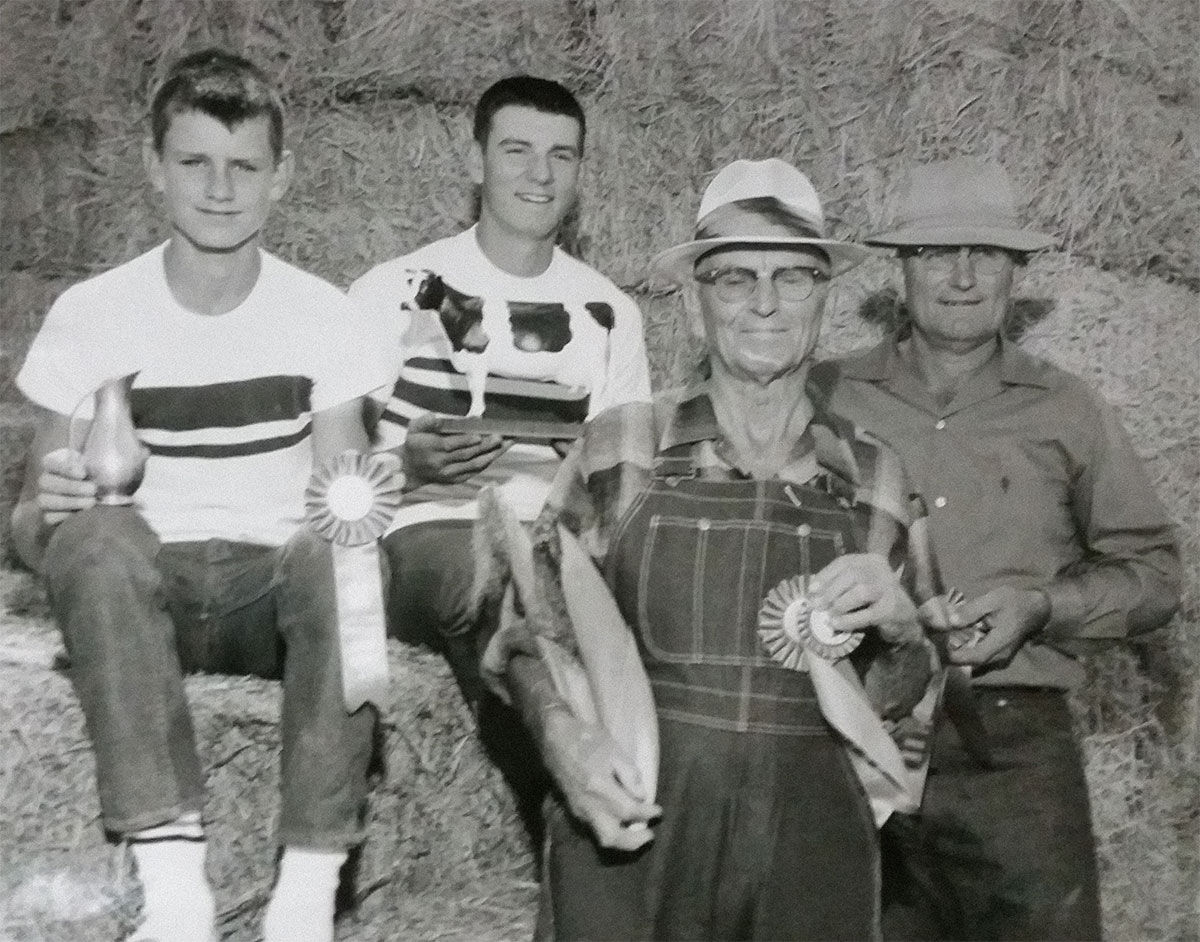History
The Social Event of the Summer for Over 125 Years.
From 1897 to the Present Day
Western Idaho Fair’s history dates back to 1897 when it got started as the Intermountain Fair. Although the foundation is the same for the Fair today as what was started all those years ago, many events have changed over time. The Intermountain Fair sprung out of a need for the community to connect Boise and other larger cities that were 300 miles apart. With Boise’s strong agricultural roots, the first Fair featured three major departments: livestock (sheep, cattle, horses and hogs), products of the soil and a domestic manufacturing/home department. These bigger categories were subdivided in later years into smaller departments that can still be found today. The Intermountain Fair highlighted Idaho’s natural resources as its prime motivation. Fair colors of purple, white and yellow symbolized fruit, silver and gold.
A second economic benefit for the Fair was the increase in local businesses to Boise. People flocked to the Fair for the exhibition and social gathering, spending money in the city. The income helped supplemented the war effort of 1943 through events such as a benefit rodeo supporting Gowen Field. Throughout the history of Western Idaho Fair, the doors have remained open since 1897 to the present with some extreme cases when it closed its doors due to severe economies. With a limited supply of volunteers in 1914, the fair board had not yet been created, and there was no one to manage the event. In 1915, the state legislature stepped in to help run the Fair. In 1922, the economy strangled the life out of the event for the next four years. During the Great Depression the grounds would not open for the Fair in another three-year stretch. Following the economic strife, in 1936 Ada County appointed a regular fair board to organize what they named “Western Idaho State Fair.” A perilous year in 1944 put the Fair on shaky ground after it was hindered by a new bill prohibiting all fairs from opening on Sundays and holidays. As a result, the 1944 Fair opened for just four days.
Even though the Western Idaho Fair has had its challenges (as most fairs realize during their tenure) one constant remains: children. Kids come to see and enjoy the Fair’s many entertainment offerings, but also to enter livestock or crafts. Area youth show those who walk through the Fair gates what their hard work has done for them. With the creation of the Intermountain Fair, 900 children walked in the opening “Queen of the Fair Parade.” In 1912, 4-H (not called 4-H at the time) began at the Fair and in 1917 the U.S. Department of Education recognized FFA as an educational organization. Since then FFA and 4-H have exploded in growth and have changed in demography. In 1969, about one-quarter of FFA members were girls. Today, girls outnumber the boys. Currently youth from all cultures and backgrounds experience the American fair in many different ways. Western Idaho Fair is no different, continuing to offer a multitude of youth activities every year.
The Main Attraction in Town
Main attractions for the Fair have changed a great deal from 1897. In the early beginnings of the Intermountain Fair, only agricultural events were held along with horse racing and cowboy contests. The Fair partnered with Boise City Jockey Club and held daily racing events reported by the local paper, Idaho Daily Statesman. Cowboy contests such as steer roping, and bronco riding drew large crowds. Horse racing and cowboy contests remained until the formation of the Snake River Stampede. Highlighting the West theme came Buffalo Bill’s Wild West Show. It was featured on August 18, 1902 and was said to be so big that it was an international show.
Just a few years into its arrival, the Fair expanded into carnival rides and games. The Ferris wheel was a much-anticipated attraction for fairgoers everywhere, as was the merry-go-round. The Ferris wheel at the Intermountain Fair was said to be the first ever west of the Mississippi. Another staple attraction was the Idaho Queen of the Fair contest. Judged by the public, local female contestants were nominated from various counties with each vote costing 10 cents. A rambunctious few would nominate prominent businessmen for crowd laughs. The First Idaho Intermountain Fair opened with the queen’s parade, a band playing the national anthem and the Queen of the Fair receiving gifts from the mayor.
Grandstand acts were not the upbeat concerts of today. Instead the Fair hosted war reenactments and sometimes plane or “dog” fights. In 1898, battles were replicated complete with soldiers and explosions, while audience members looked on from the safety of their seats. Battles depicted wars with Germany and even Napoleon. On April 20, 1911, the Wright Brothers and Glen Curtiss sent their planes for an exhibition. Aviation was the highlight again when Charles A. Lindberg made an appearance on September 4, 1927; Lindberg was famous for his solo flight from New York to Paris. Apart from the big acts, smaller entertainment on the grounds was available. Music was always present with many bands sprinkled around the grounds for patrons to enjoy. The First Regiment Band of Utah performed in 1902.
Western Idaho Fair has come a long way with grounds entertainment showcasing national bands to dock dogs to a carnival section that has expanded to more than seven acres. Night shows at the grandstand feature big-name artists from country music to classic rock. Yet the foundation of the Fair is still agriculture, where patrons can watch chickens hatch, see a top livestock show or view the latest organic produce.
Where It’s At, Then and Now
Western Idaho Fair has not always been located where it is today on Glenwood Street. In fact, the Fair has moved three times in its history. The first location was west of the city at the Idaho Agricultural Park, known at present day as 21st Street between State and Idaho. The park was the site of the Fair in the fall of 1897 and a grandstand was built that looked over a scene of the majestic mountains.
Soon the Fair outgrew its beginning location. In 1902, the Idaho Intermountain Fair Association moved to the corner of Fairview and Orchard. Fairview and Orchard was more of a distance for fairgoers than in the center of town, but with new innovations like horse drawn carriages, trains and cars, fairgoers came willingly. This new location held some changes for the Fair such as construction of a one-mile oval racetrack. The track grandstand seated 2,000 spectators. A main exposition building built 150 feet long with 50 foot wings was fully equipped—including a saloon.
The last and final move was to Glenwood Street and Chinden Boulevard in 1967, when the Fair assumed its current name of Western Idaho Fair. Fairgoers demanded different kinds of entertainment by this time, and the grandstand acts changed along with the new location. A rodeo was not booked at the new location until 1988, and was later phased out due to local competition by the nationally-recognized PRCA rodeos, Snake River Stampede and Caldwell Night Rodeo.
How the Fair Gets Funded
Some wonder if the Western Idaho Fair is the official state fair of Idaho. Although the Western Idaho Fair is the direct descendent from the first Intermountain Fair held in 1897, it is not the state fair of Idaho. In fact, no fair in Idaho receives funding from the state, similar to fairs operating in Montana, New Hampshire, Washington, and other states. In 1914, next door neighbor Canyon County assumed the title as “state fair” allowing Boise volunteers to run an interim fair. Although Canyon County had the state fair title, Ada County bought Intermountain Fair’s grounds to create an “old time fair” that would focus on the fair work and products without the thrills like carnival rides. Canyon County’s fair would precede the Intermountain Fair by one week, yet no resentments were held between the two counties. Canyon County would have a Boise day and the Intermountain Fair hosted a Canyon County day. Winners from Canyon County would take their winning goods to the Intermountain Fair for competition and vice versa.
Between 1887 and 1915, many counties started to hold their own individual fairs but still coveted the “state fair” title that had once belonged to the “Boise” fair, still without any state funding. In 1915, under Ada County management, officials called the Fair the Gem State Fair while Canyon County named its Fair “Idaho State Fair” that same year. For a brief window in time, the state of Idaho stepped in to support the Gem State Fair, officially naming the event the Idaho State Fair and retiring the Gem State name. But with the 1922 financial hardships—closing many area businesses as well as the Idaho State Fair—the state withdrew its support. Ada County assumed funding support for Western Idaho Fair at that time.
Since the mid-1980s, Western Idaho Fair has been independent of any taxpayer support. Entitled an “enterprise fund,” it is entirely self-funded, including salaries, capital improvements, and other costs. Ada County officially owns the property and buildings. In 2003 officials renamed the property “Expo Idaho” in order to attract more business to the facility during offseason (non-fair) months.
More than 250,000 people attend Western Idaho Fair and another 750,000 come through the facilities for trade shows, auctions, sporting events, livestock activities and company gatherings. The current director, Bob Batista, is the longest-serving fair manager in its history.


